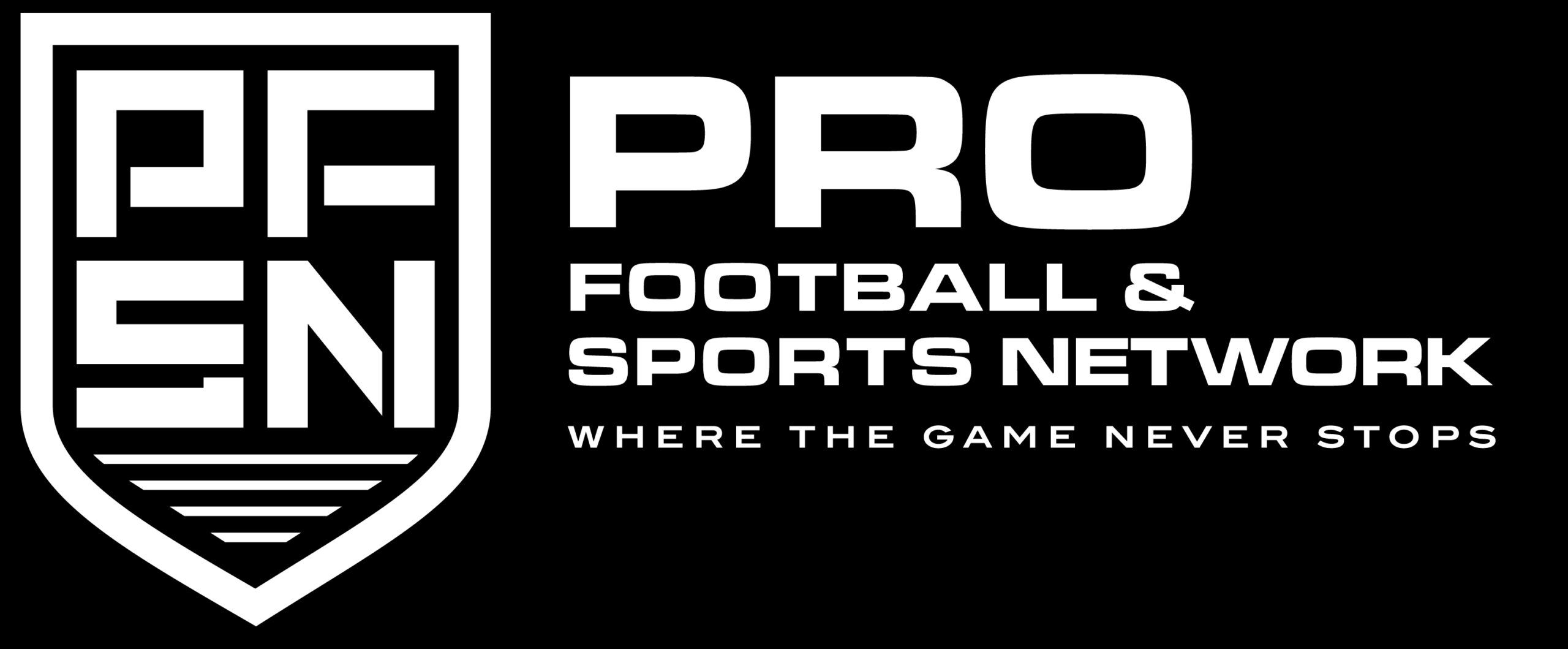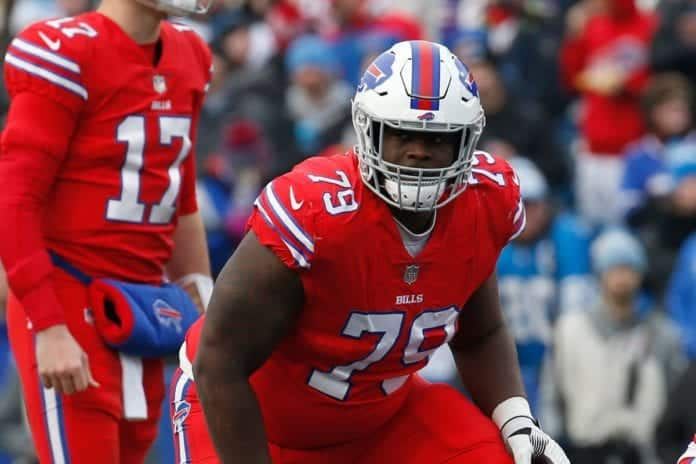In March, Ja’wuan James said farewell to the Miami Dolphins – who drafted him in the first round in 2014 – as he signed a record 4-year deal with the Denver Broncos worth $51 million.
Injuries aside, James had been a solid right tackle for Miami. He had shown flashes of stardom, including a Week 6 overtime win against the Chicago Bears when he kept the 2017 National Football League Defensive Player of the Year, Khalil Mack, in check the entirety of the game. Even Von Miller, Denver’s elite pass-rushing linebacker, recently praised James as being the best right tackle he has ever had to go up against – at least in practice.
It is unclear who will replace James, but the presumed starter is a 6-year veteran, Jordan Mills. Mills, a 2013 fifth-round pick of the Chicago Bears, started all 16 games for the Buffalo Bills in each of the past three seasons. In May, the Miami Dolphins signed him to a sensible 1-year contract worth $3 million.
Fans may remember Mills as being the lone Buffalo player ejected in Week 17 last year (along with Robert Quinn and Kiko Alonso, both of Miami) after Alonso was penalized for a late hit on rookie Buffalo quarterback Josh Allen. Aside from that, Mills is not very well known in Miami. And to many in the industry, Mills is considered just an average right tackle at best.
Here, at the Pro Football Network (PFN), our PFN Data Lab has graded the pass blocking behaviors of both Ja’wuan James and Jordan Mills during the 2018 season. If Mills is named the starter after training camp, the analysis below will provide some insight into what can be expected of him in 2019.
Overall grades
Perhaps surprising to some, both James and Mills received the same PFN grade for offensive tackles in 2018 with 75 (out of 100). They also received weighted average scores of 74, which factors in snap counts against the average. Compare these to Laremy Tunsil, currently PFN’s highest-rated tackle (77), and you may have already found a new appreciation for both James and Mills. If you haven’t already done so, check out Lucas Ellinas’ article for some great insight into why Tunsil is an elite tackle, as well as an overview of the PFN Data Lab grading process for offensive tackles.
From those grades alone, there doesn’t appear to be a drop-off in talent by replacing James with Mills. When considering such factors as penalties and sacks against the number of starts, there isn’t a huge gap either, as noted by PFN’s own Matt Infante when Miami signed Mills.
Per STATS LLC:
Jordan Mills 2018: 7 penalties, 6.5 sacks allowed
Ja’Wuan James 2018: 3 penalties, 5 sacks allowedNot a huge difference, considering their salaries in 2019. Mills also hasn’t missed a game over the past 3 years while James has missed 9.
— Matt Infante (@MattyInfante) May 9, 2019
Grades by game
Let’s take a closer look at Ja’wuan James’ and Jordan Mills’ grades, on a week-by-week basis.
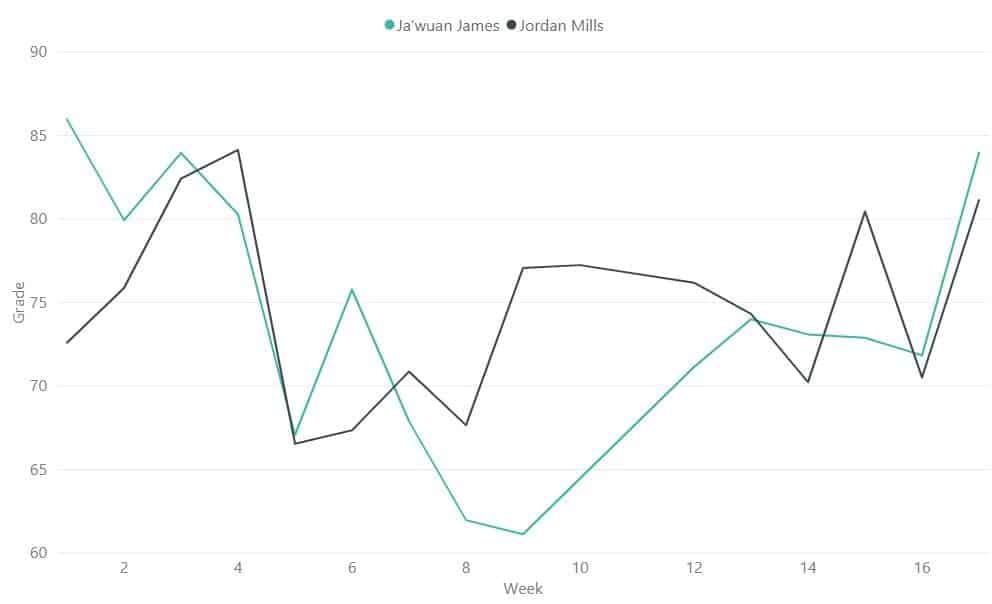
As expected, each player had their ups and downs throughout the season. Mills was a little more consistent, though not overwhelmingly so. James had a few more games where he played at an elite level, primarily in the beginning of the season, offset by some low grades mid-season.
James struggled in a Week 5 loss to the Cincinnati Bengals, where he was eventually replaced by Sam Young. Heading into Week 9 against the New York Jets, his grade dropped two weeks in a row. He suffered a knee injury that game which kept him sidelined the following week as well. After the Week 11 bye, James began to get his rhythm back and finished the year on a high note against the Buffalo Bills.
Mills was more of an anomaly at times. In Week 4, he had his highest grade of the season in a shutout loss to the Green Bay Packers 22-0. He followed it up with his lowest grade of the season in a 13-12 win against the Tennessee Titans.
To see how each progressed throughout the season, consider the trend lines as shown below.
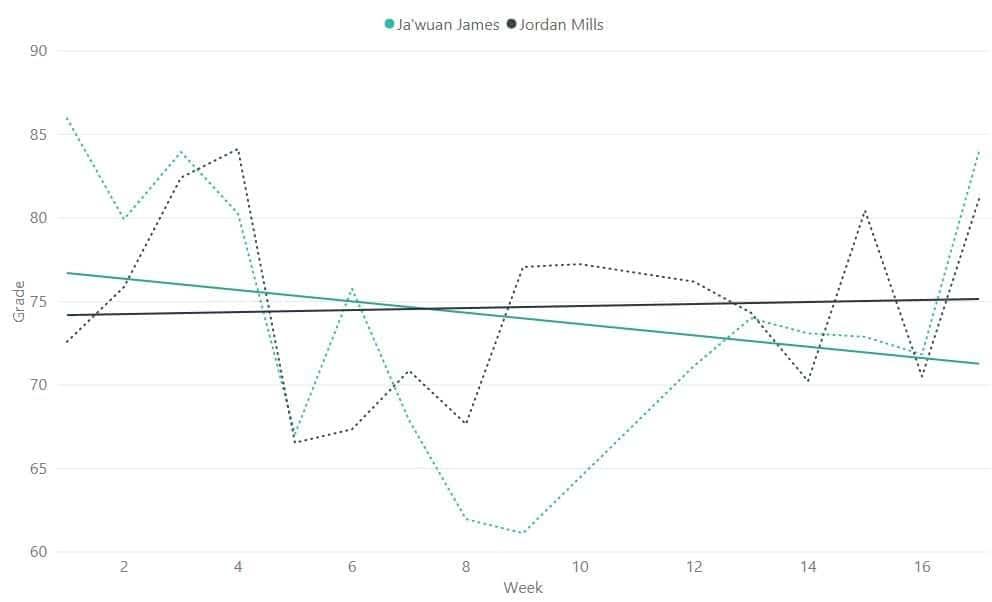
Seasonal grading is never linear, but if you take into account where each started the 2018 season, and where they ended up, you can see that James was on the decline while Mills improved slightly. Perhaps this was one reason the Miami Dolphins did not seek a new contract with James and were willing to grab Mills as a potential replacement.
Let’s continue to compare James and Mills by digging a little deeper into actual game-play scenarios.
Grades by down
James and Mills scored virtually the same grades on 1st, 2nd, and 3rd down. On 4th down, however, Mills was exceedingly superior to James. Amazingly enough, the number of 4th down passing plays were nearly identical – eight for Miami, nine for Buffalo.
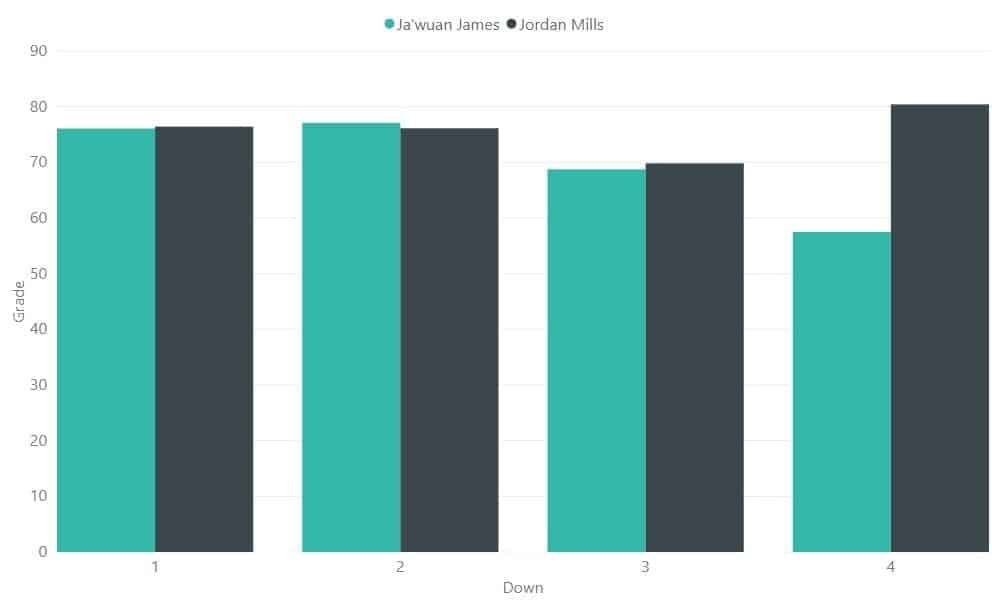
Grades by short pass
Here’s where we really start to see some differences in pass blocking grades between the two. On short passes (attempts less than 15 yards), James performed at a much higher level when the ball was thrown to the outside. Mills, on the other hand, graded higher when the ball was thrown to the opposite side of the field from where he typically lines up.
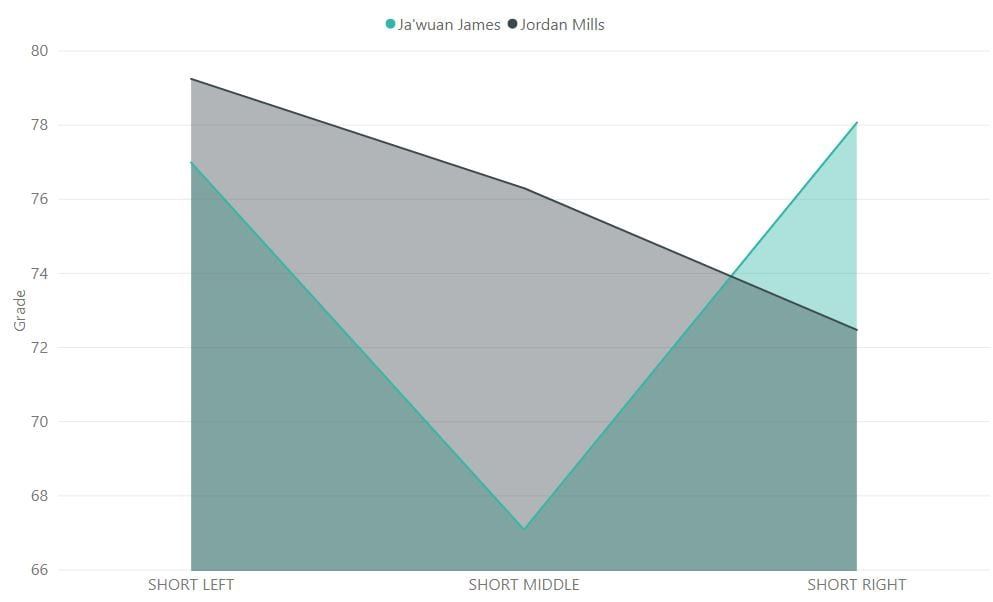
Grades by deep pass
On deep passes (attempts greater than 15 yards), both performed the best when the ball was thrown in the middle of the field.
This is one place where Ja’wuan James excelled, allowing plenty of time (alongside Laremy Tunsil) for Ryan Tannehill and Brock Osweiler who combined for a 63% completion rate on 19 (deep middle) attempts, resulting in 4 touchdowns and 0 sacks. Ironically, James’ grading on the deep pass was the mirror image of the short pass, where he struggled (in comparison) when the ball was thrown to the outside.
Jordan Mills was fairly consistent, regardless of where the ball was thrown. Buffalo had 50% more deep passes in the middle of the field as Miami did in 2018 and Mills was most successful when that area of the field was targeted. Similar to the short pass, Mills graded lowest when the ball was thrown to the strong side, where he lined up.
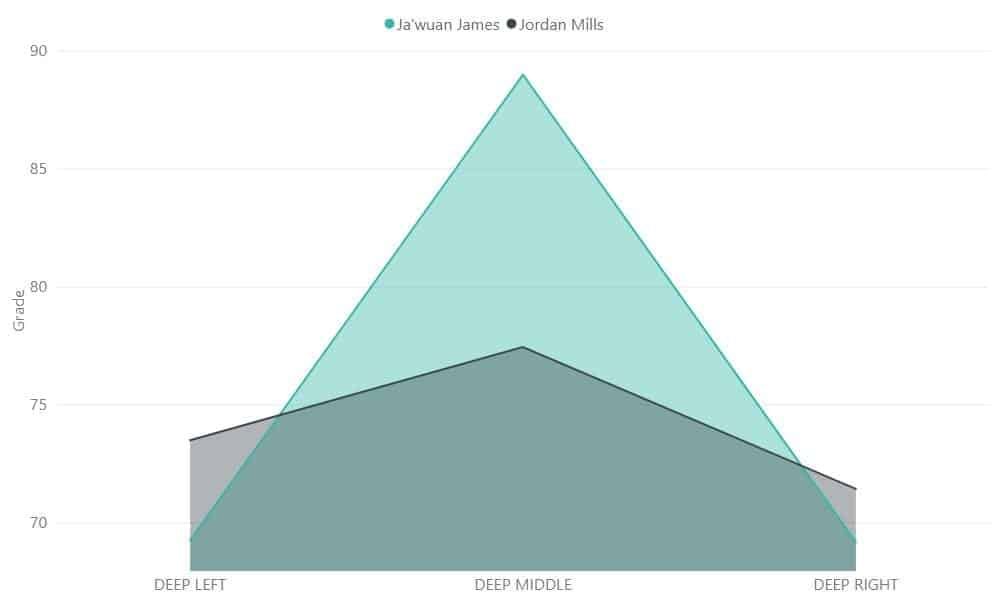
Grades by formation
Neither performed very well when the offense was in a standard (huddle) shotgun formation. However, James was best in the no-huddle shotgun formation. For Miami, most passes (61%) were thrown short left or right, which is when he provided his best protection as noted above. Similarly, under center, passes were thrown short and to the outside 59% of the time.
Mills excelled during the no-huddle offense (under center) with the primary factor being that Buffalo threw the ball short left 60% of the time. The majority of Buffalo’s passes that were thrown short right (72%) were actually from shotgun or no-huddle shotgun formations, so it’s not a huge surprise that Mills didn’t perform as well as he did when the quarterback was under center.
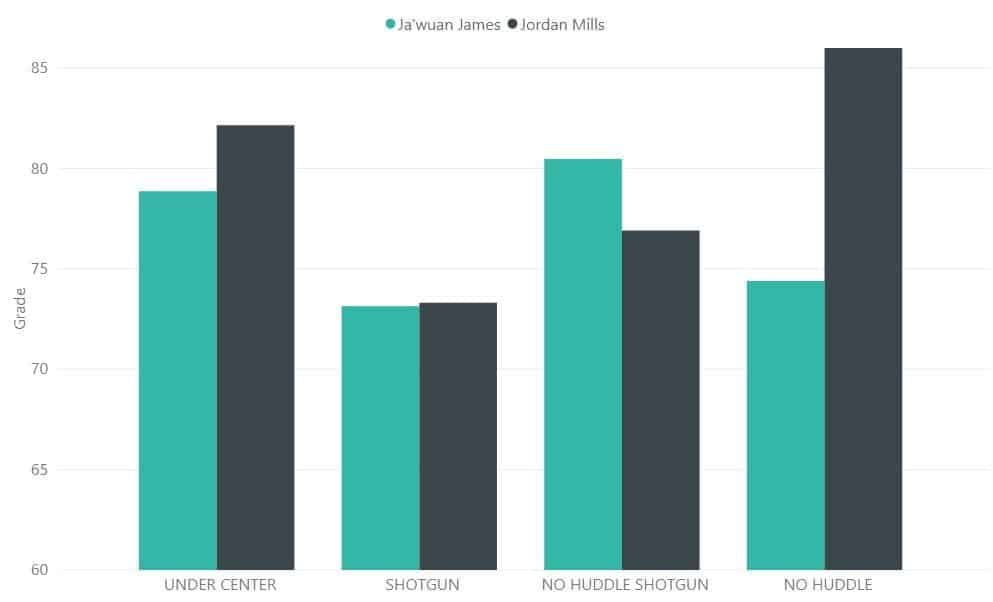
Grades by yard line
In the graph below, 0 represents the end zone being defended. The closer to 100 you get, the closer the offense is to scoring (i.e., yard line 80 to 100 is the red zone).
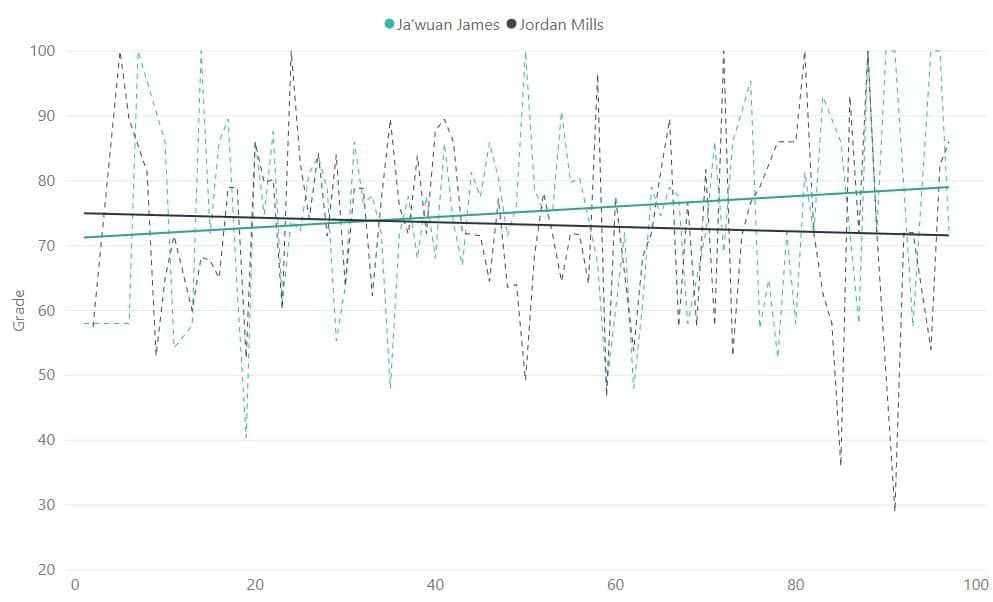
As one can see, Mills performed very well around the opponent’s 20-25 yard line (right before and at the 80-yard line on the graph). In the red zone itself, he was very up and down. However, throughout the season, his performance was fairly consistent. There’s a slight decline of a few percentage points from left to right, primarily from his play in the red zone, but nothing stands out that would overly produce a sense of unreliability among coaches, teammates, and fans.
James struggled some getting into field goal range (as did Mills, around yard line 60 on the graph) as well as getting into the red zone (opposite of Mills) but excelled once in the red zone. He struggled more when the ball was backed up on Miami’s side of the field, but his performance in the red zone portrays someone who performs at a higher level the closer they are to scoring and was likely a factor in obtaining a record contract this year.
For the sake of the New England Patriots
Lastly, let’s consider how Ja’wuan James and Jordan Mills performed against the New England Patriots. Both James and Mills had to play New England twice last year. Both are very familiar with New England’s defense and, with Brian Flores coming to Miami as head coach from New England, he may see something in these players that aren’t as obvious to the rest of us.
Against New England, James had grades of 81 (Week 4) and 74 (Week 14), while Mills had grades of 68 (Week 8) and 71 (Week 16). On paper, it’s obvious that James performed better than Mills. However, Flores also brought Chad O’Shea with him from New England (and likely similar offensive schemes) to be Miami’s offensive coordinator.
A review of a few New England tendencies may clarify if James or Mills would be better suited for a Chad O’Shea led offense, regardless of their grades against the defense that won Super Bowl VIII.
- In 2018, New England passed to the left 42% of the time on short passes and middle/right 24%/34%, respectively
- Advantage: Split, as most passes were to the outside (James) but heavier on the left side of the field (Mills).
- New England’s deep passes last year were close to evenly split left/middle/right (28%/36%/36%)
- Advantage: Mills, as he is more consistent on deep throws regardless of where on the field it is thrown.
- New England lined up under center 28% of the time in 2018
- Advantage: Mills, due to his elite play from that formation.
- Note: New England started in standard (huddle) shotgun formation 65% of the time; neither James nor Mills had a clear advantage over the other in this category.
- Advantage: Mills, due to his elite play from that formation.
Putting it all together
Mills was a little more consistent from week-to-week compared to James and appeared to have progressed slightly throughout the season. He excelled when the ball was thrown to the opposite side of the field on short pass plays and was reliable on deep pass plays, regardless of the section of the field. In high-pressure scenarios, Mills was excellent during 4th down passing plays. However, he struggled slightly when in scoring position (getting into field-goal range and inside the red zone).
Although it’s unclear if Jordan Mills will be able to fill Ja’wuan James’ shoes for the Miami Dolphins in 2019, the question remains: is Miami in a better or worse situation without James’ presence at right tackle? All things considered, Miami may have found the answer in Mills, while also saving over $9 million and relinquishing any concerns of recurring injuries.
All player data used in this analysis was sourced internally from PFN Data Lab metrics. Other data, specifically play-by-play information, was referenced from publicly available content at NFL Savant.
[sv slug=”pfnaa”]